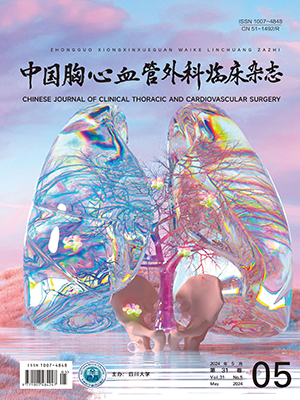Abstract: Objective To explore the application of lower sternal incision with on-pump, beating heart intracardiac procedures in mitral valve replacement (MVR). Methods We retrospectively analyzed clinical data of 42 patients (minimal incision group) with valvular heart diseases who underwent MVR via lower sternal incision under the beating heart condition in Xinqiao Hospital of the Third Military Medical University from January 2011 to December 2011. There were 16 male and 26 female patients with their average age of 42.3±12.7 years in the minimal incision group. We also randomly selected 42 patients with valvular heart diseases who underwent MVR via routine midline sternotomy during the same period in our department as the control group. There were 18 male and 24 female patients with their average age of 43.8±13.1 years in the control group. Operation time, cardiopulmonary bypass time, major complications, chest drainage in postoperative 24 hours, skin incision length and average postoperative hospital stay were observed and compared between the two groups. Results There was no major perioperative complication such as in-hospital death. There was no reexploration for postoperative bleeding, complete atrioventricular block, embolism or perivalvular leakage in the minimal incision group. There was no statistical difference in cardiopulmonary bypass time, operation time, or the incidence of reexploration for postoperative bleeding, wound infection and perivalvular leakage between the two groups(P>0.05). The skin incision length in the minimal incision group was shortened by 5.2 cm compared to that in the control group (7.9±1.4 cm vs. 13.1±3.3 cm, P=0.000). Chest drainage in postoperative 24 hours in the minimal incision group was significantly less than that of the control group (183.6±40.2 ml vs. 273.4±59.9 ml, P=0.000). Postoperative hospital stay in the minimal incision group was significantly shorter than that of the control group (8.1±1.3 d vs. 10.6±2.1 d, P=0.000). Forty patients in the minimal incision group were followed up for 3-15 months and 2 patients were lost during follow-up. Four patients had postoperative wound pain, and the majority of patients didn’t have significant wound scar formation but a satisfactory quality of life. Thirty-eight patients in the control group were followed up for 3-15 months, 4 patients were lost during follow-up, and 17 patients had postoperative wound pain. Conclusion Lower sternal incision with beating heart can reduce the surgical injury, simplify the operation procedure and improve the therapeutic efficacy. It is a safe, effective and esthetic surgical approach for MVR.
Citation: CHENG Wei,XIAO Yingbin,CHEN Lin,LIU Hong.. Application of Lower Sternal Incision with On-pump, Beating Heart Intracardiac Procedures in Mitral Valve Replacement. Chinese Journal of Clinical Thoracic and Cardiovascular Surgery, 2013, 20(1): 33-36. doi: Copy




